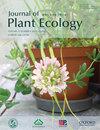The nonlinear change in pollinator assemblages and self-mating syndromes of Primula atrodentata along elevation gradients
IF 3.9
2区 环境科学与生态学
Q2 ECOLOGY
引用次数: 1
Abstract
The reproductive strategies of alpine plants are often altered by environmental changes caused by changes in the spatial distribution of the gradient. However, few studies have investigated whether reproductive patterns of the same species vary with elevation. Three natural populations of Primula atrodentata, which are distributed in the eastern Himalayas and have a long flowering period, were selected along the elevation gradients in Shergyla Mountain, Tibet, China. Morph ratio investigation, floral trait measurement, pollinator observation, and manipulated pollination experiments were conducted to explore the changes in self-compatibility and floral traits associated with the selfing syndrome along elevation gradients. We found that the breeding system of the S-morph is facultative outcrossing, and that of the L-morph is obligatory outcrossing. We further found that with increasing elevation, the number of pollen and ovules, anther-stigma distance, and inbreeding depression index first increased and then decreased, whereas the seeds per fruit and seed setting rate under hand self-pollination, pollen limitation, and self-incompatibility index tended to decrease first, but then increased. In addition, pollinator diversity and visiting frequency were the highest at the middle elevation (4050 population), which can better explain the non-linear change in self-fertility with elevation. Our findings provide insights into the evolutionary pattern of self-compatibility in alpine plants along elevational gradients.报春花传粉者组合和自交综合征沿海拔梯度的非线性变化
高山植物的繁殖策略往往会因梯度空间分布的变化而引起的环境变化而改变。然而,很少有研究调查同一物种的繁殖模式是否随海拔高度而变化。根据海拔梯度,选择了三个生长于喜马拉雅山脉东部、花期较长的尖齿报春自然种群。通过形态比调查、花性状测量、传粉者观察和人工授粉实验,探讨了海拔梯度上与自交综合征相关的自交亲和性和花性状的变化。结果表明,S型为兼性异交,L型为强制性异交。我们进一步发现,随着海拔的升高,花粉和胚珠的数量、花药柱头距离和近交抑制指数先增加后减少,而人工授粉、花粉限制和自交不亲和指数下的单株种子和结实率有先减少后增加的趋势。此外,传粉昆虫多样性和造访频率在中海拔地区最高(4050个种群),这可以更好地解释自育性随海拔的非线性变化。我们的发现为高山植物沿海拔梯度的自我相容性进化模式提供了见解。
本文章由计算机程序翻译,如有差异,请以英文原文为准。
求助全文
约1分钟内获得全文
求助全文
来源期刊

Journal of Plant Ecology
生物-植物科学
CiteScore
4.60
自引率
18.50%
发文量
134
审稿时长
3 months
期刊介绍:
Journal of Plant Ecology (JPE) serves as an important medium for ecologists to present research findings and discuss challenging issues in the broad field of plants and their interactions with biotic and abiotic environment. The JPE will cover all aspects of plant ecology, including plant ecophysiology, population ecology, community ecology, ecosystem ecology and landscape ecology as well as conservation ecology, evolutionary ecology, and theoretical ecology.
 求助内容:
求助内容: 应助结果提醒方式:
应助结果提醒方式:


